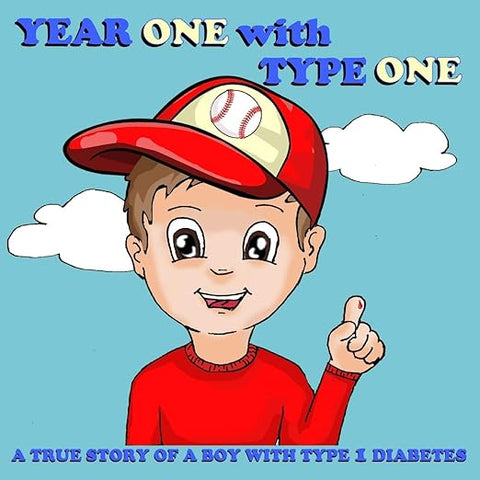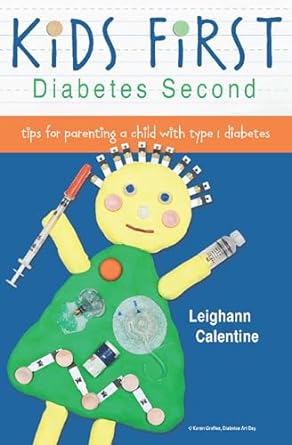In the United States alone, an estimated 400,0000 adolescents under the age of 20 are living with diabetes, a number that experts expect will continue to grow. While Type 2 diabetes usually presents during the teen years, Type 1 diabetes is commonly diagnosed in children between the ages of 5 and 7 years old. When a child presents with symptoms, like excessive thirst, fatigue, and weight loss, a visit to the endocrinologist is important. And if the diagnosis is positive, gather some of the best kids' books about diabetes that teach them how they can manage their disease and still live their best, most active lives.

A very accessible picture book for preschoolers who are newly diagnosed. Andrew has just learned that his pancreas does not produce insulin, so now he has to take on a lot of responsibility for his own well-being. Playful, cartoonish illustrations are paired with bouncy rhyming text in this upbeat, educational diabetes book for children. Helpful tips about disease managements are woven throughout, but the focus is primarily on a little boy living a very active, fun-filled life.

Children's Books With Diabetic Characters
Seeing these characters living their best lives is a great way to give your child a boost! Stories about healthy eating, monitoring sugar levels, staying away from sugary treats, and getting lots of exercise reinforce the importance of these behaviors in children. Packed with facts about diabetes, these titles are invaluable tools for teaching little ones everything they need to know. Book about characters with diabetes who learn how to eat the right foods and monitor their sugar levels while leading active lives is helpful. Little ones will learn that incorporating healthy movement like yoga and other forms of exercise can help with both the physical and mental management of the disease.
Picture Books Teach Kids How to Manage Diabetes
Kids can feel very much isolated and alone in the management of their disease, especially at school and social outings when it seems like the rest of their peers don't have a care in the world. For this reason, it's a good idea to read children's books about diabetes. There are lots of diabetic-friendly recipes for kids included in these books, as well as tips for choosing the right snacks to keep sugar levels in check all day long. Most importantly, reading will help your child understand that this disease can be effectively managed. These stories will show your child that the disease doesn't have to define them or get in the way of having fun. In the beginning, it may be tough to make some pretty big adjustments and take on a lot of responsibility. With the right attitude and discipline, adolescents can do what it takes to stay healthy and active!

Taking Diabetes to School
A very easy-to-understand straightforward account of what life is like for a grade-schooler with diabetes. The little boy openly shares details about his condition with classmates and explains all of the things he does to manage his blood-sugar levels. There is a helpful quiz for kids who need to learn all the important terminology and steps they need to take to stay healthy.

Zeus, Dog of Chaos
Navigating middle school is tough enough, but for Madden, it's even harder with a service dog by his side. When his blood sugar level drops too low, Zeus, a German Shepherd, is there to alert him. This type of attention is exactly what Madden wants to avoid. On top of his diabetes, he is dealing with other issues like making amends with his mother and trying to win a band competition. A helpful middle-grade novel for every tween who is dealing this disease along with all of life's other challenges.

Sweet Steps
Abbi is a talented, hardworking dancer who is living with Type 1 diabetes. Her dreams of performing center stage are dashed when she experiences drops in sugar levels while dancing. Another dancer with the disease boosts her spirits and shows her that she can achieve her goals by managing her diabetes more effectively.

I Have Diabetes
This helpful picture book about diabetes will help young children learn about this disease. The charming, child-like drawings help to soften the message about managing juvenile diabetes. Readers will learn why they need insulin, the reason for checking their glucose levels, and why it is important for them to follow a specific diet.

Kids First, Diabetes Second
This award-winning guide for parents was written by a mother who has experience raising a diabetic child. The objective of this book is to help parents create an environment in which their kids thrive. The author offers tons of advice around the automation of tasks so that this disease does not take over a child's life. In addition to offering tactical tips, the book is full of encouragement and tips for managing the emotional toll this disease can take on a family.

Even Little Kids Get Diabetes
A simple picture book for little kids who are figuring out life with diabetes. Children will learn a little bit about how to manage their diet and how to make good choices when around other kids who don't have food restrictions. Colorful illustrations and an overall upbeat message.

Nothing Can Stop Me!
This story is based on the real experiences of the author, a hockey player who was diagnosed with Type 1 diabetes. As a star athlete on the team, Bobby was instrumental in taking his team to the championships. But when he feels ill after the game, a doctor diagnosis him with a condition that he fears will squash his hockey ambitions. Fortunately, with the guidance and support from medical professionals and family, he is able to return to the rink better than ever.

Ballerina Dreams: A Book for Kids With Diabetes
Zippy is a talented ballerina who has worked hard to land the leading role in an upcoming production. She practices tirelessly so that her technique is absolutely perfect. But then, in the midst of all of her rehearsals, Zippy is diagnosed with diabetes. Her world is turned upside down and she is afraid her ballet career is over. Zippy digs deep and finds the strength to manage her new medical responsibilities and still keep up with her ballet. An inspiring story for children who will learn that giving up is not an option, even with the extra challenge of a health disorder.

The Ups and Downs of Audrey May
Audrey may is used to a life full of uncertainty. She is a bright nine year old who has traveled her entire life with her father, who works in the film industry. Finally, the day comes when her family settles down and she can go to a regular school. This big change brings all kinds of challenges for Audrey May, but then her world is really rocked when she is diagnosed with Type 1 diabetes. With the support of her parents and her little sister, Audrey May can overcome all these new challenges in her life.

Emma's Extra Snacks: A Story About Type 1 Diabetes
Caillou's friend, Emma, has Type 1 diabetes. The only difference Caillou notices is that she is allowed to have extra snacks at school. But he's worried that she has an illness, like the flu, so he takes great caution when playing with her. When Emma beats him in a race, Caillou finally understands that she can be active and play just like everyone else. Perfect tone and message for preschoolers.

Another D for DeeDee
A realistic, coming-of-age novel about DeeDee, a girl whose difficult life is made more challenging with her recent diagnosis of diabetes. DeeDee is already struggling with the sudden disappearance of her father and the fact that her brother dropped out of high school. When she is forced to change schools, she has a difficult time making new friends. Life takes a turn for the better when she meets a boy who also has a medical issue to manage. They become fast friends, but when he transfers to her school, she is embarrassed by his condition and does not behave like a loyal friend. There are a lot of important lessons throughout this thought-provoking book about a diabetic teenager.

It All Begins With Jelly Beans
A middle grade chapter book about two girls figuring out how to navigate personal circumstances and survive middle school. Meg is dealing with instability at home, where the refrigerator and cabinets are often bare and she doesn't have enough clothing. Riley's problems are related to her health and learning how to manage her diabetes in light of other adolescent challenges. The girls bond over a bag of jellybeans as they figure out how to lean on each other and form a special friendship.

The Dinosaur Tamer and Other Stories for Children With Diabetes
The American Diabetes Association produced this extremely helpful book for young children. There are twenty-five fictional stories about different characters who are learning to manage their diabetes. The tone of the book is very upbeat and includes tons of helpful medical information that little readers will understand. Some of these stories also address the emotional side of the disease which will encourage kids to talk about their feelings.

Super Sammy! A Tale for Type 1 Superheroes
Sammy is a little boy with a big imagination. He and his best friend, Scout, spend their days pretending to be superheroes. But when Sammy is diagnosed with Type 1 diabetes, he is worried that his superhero days are over. Fortunately, as he learns about the disease and how to manage it, Sammy realizes that his life doesn't have to change. A reassuring story with factual information about Type 1 diabetes in young children.

Diabetes Doesn't Stop Maddie!
Maddie is an active, athletic little girl who was recently diagnosed with Type 1 diabetes. Just like most kids who have to face this disease, she is worried that she won't be able to take on the responsibility of managing it. Maddie is also nervous about telling her friends, but after she opens up about it, she feels much better. In no time at all, she is back to playing soccer, going to school and enjoying her time with friends!

Teddy Talks: A Paws-itive Story About Type 1 Diabetes
The author, a mother of two children with Type 1 diabetes, blends a reassuring story with solid, straightforward advice about managing the disease. Teddy, a fabulous fur friend, shares all kinds of useful information about he and Emily stay healthy together. They eat healthy foods and monitor sugar levels all throughout the day. But most importantly, they don't let Emily's diabetes stand in the way of having fun. A useful glossary contains helpful terms, and there are tips for using the continuous glucose monitor.

Was It Something I Ate?
A humorous, rhyming book will put every child with type 1 diabetes at ease. In accessible, kid-friendly language, the author (who happens to be a diabetes educator) clears up a lot of misconceptions about the disease. Kids are also introduced to terms that may sound scary and new, like pancreas, insulin, and autoimmune. But by reading this book, kids will feel much better about their diagnosis and empowered with information to help them manage their health.
Picture Books About Childhood Health Issues
These books serve as a vital educational tool. They translate complex medical information into simple, engaging language and illustrations, helping a child understand their body and their treatment. For example, a story can clearly explain the process of blood sugar checks or insulin injections, demystifying scary procedures. Beyond the facts, the narratives offer powerful emotional support. Seeing characters who look just like them successfully managing a health issue normalizes their experience, making them feel less alone and isolated. This normalization is key to building confidence and resilience, showing the child they can be a "regular kid" who still goes to school, plays with friends, and pursues their interests despite their diagnosis.







